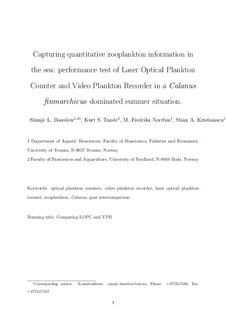Capturing quantitative zooplankton information in the sea : Performance test of laser optical plankton counter and video plankton recorder in Calanus finmarchicus dominated summer situation
Journal article, Peer reviewed
Permanent lenke
http://hdl.handle.net/11250/141124Utgivelsesdato
2012Metadata
Vis full innførselSamlinger
Originalversjon
Basedow, S.L., Tande, K.S., Norrbin, M.F. & Kristiansen, S.A. (2012). Capturing quantitative zooplankton information in the sea: Performance test of laser optical plankton counter and video plankton recorder in a Calanus finmarchicus dominated summer situation. Progress in Oceanography, 108, 72-80. doi: 10.1016/j.pocean.2012.10.005Sammendrag
We compared two optical plankton counters, the Laser Optical Plankton Counter (LOPC) and the Video Plankton Recorder (VPR) for their abundance estimates of Calanus finmarchicus during an early summer situation (June 2008) in two North Norwegian fjords. The LOPC was mounted on the VPR frame in order to sample the same body of water. The combined system of LOPC and VPR was operated by vertical profiling from the surface to 100 m of depth in several locations of the fjords representing different blooming conditions and zooplankton community structures. Data from the two instruments, as well as from CTD-F, were logged concurrently and retrieved on deck after about 15 depth profiles. Primary data were analysed according to standard routines, and choices made during sampling and analyses (sampling volume, selection of size range, transparency of particles, statistics) are discussed. Data were averaged for every 5, 10 and 15 m depth bins. The vertical profiles of C. finmarchicus CIV–CVI abundance that were obtained by LOPC and VPR, respectively, showed a striking similarity. No significant differences between profiles sampled by these two instruments were observed when data were binned into 15 m bins. At low abundances (<100 Calanus sp. L−1) profiles were significantly different when data were binned into 5- or 10-m bins. This is attributed to the small sampling volumes of the LOPC and the VPR, and to very patchy distributions of copepods, resulting in a high standard deviation between consecutive profiles. Based on the results we conclude that the time is mature for a more extensive use of optical instruments to estimate zooplankton abundances and distributions in the sea.
